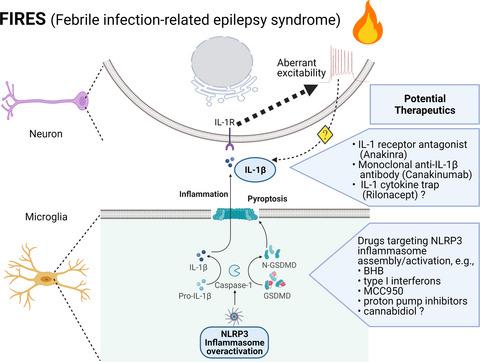当前位置:
X-MOL 学术
›
Clin. Transl. Immunol.
›
论文详情
Our official English website, www.x-mol.net, welcomes your
feedback! (Note: you will need to create a separate account there.)
Hypothesis: Febrile infection-related epilepsy syndrome is a microglial NLRP3 inflammasome/IL-1 axis-driven autoinflammatory syndrome
Clinical & Translational Immunology ( IF 4.6 ) Pub Date : 2021-06-14 , DOI: 10.1002/cti2.1299 Wei-Sheng Lin, Ting-Rong Hsu
Clinical & Translational Immunology ( IF 4.6 ) Pub Date : 2021-06-14 , DOI: 10.1002/cti2.1299 Wei-Sheng Lin, Ting-Rong Hsu

|
FIRES (febrile infection-related epilepsy syndrome) is a protracted neuroinflammatory condition of obscure cause. It mainly afflicts school-age children and often leads to permanent neurological sequelae. Most treatments to date have been of limited efficacy, while ketogenic diet and anti-interleukin-1 therapy appear beneficial for some patients. Research into this clinical entity is hampered by its rarity and complexity. Nonetheless, accumulating evidence derived from basic investigations and clinical observations converges to implicate the autoinflammatory nature of this syndrome. A closer analysis of current literature suggests that microglia and the NLRP3 inflammasome might be the pivotal cellular and molecular players in FIRES pathogenesis, respectively. Through evidence synthesis, herein we formulate the working hypothesis of overactivation of microglial NLRP3 inflammasome/interleukin-1 axis as the driving event in FIRES by creating a proinflammatory and proconvulsive milieu. The reverberation between neuroinflammation and seizure forms a vicious cycle. The unique properties of microglia might also contribute to unopposed IL-1 signalling and incessant sterile neuroinflammation in this context. The potential therapeutic relevance of the proposed conceptual framework is discussed.
中文翻译:

假设:发热性感染相关癫痫综合征是一种小胶质细胞 NLRP3 炎症小体/IL-1 轴驱动的自身炎症综合征
FIRES(发热性感染相关癫痫综合征)是一种病因不明的慢性神经炎症性疾病。它主要影响学龄儿童,并经常导致永久性的神经系统后遗症。迄今为止,大多数治疗效果有限,而生酮饮食和抗白细胞介素 1 治疗似乎对某些患者有益。对该临床实体的研究因其稀有性和复杂性而受到阻碍。尽管如此,从基础研究和临床观察中获得的越来越多的证据都表明该综合征的自身炎症性质。对当前文献的进一步分析表明,小胶质细胞和 NLRP3 炎症小体可能分别是 FIRES 发病机制中的关键细胞和分子参与者。通过证据综合,在此,我们通过创建促炎和促惊厥环境,将小胶质细胞 NLRP3 炎症小体/白细胞介素-1 轴过度激活作为 FIRES 的驱动事件制定工作假设。神经炎症与癫痫发作之间的回响形成恶性循环。在这种情况下,小胶质细胞的独特特性也可能导致不受抑制的 IL-1 信号传导和持续的无菌神经炎症。讨论了拟议概念框架的潜在治疗相关性。在这种情况下,小胶质细胞的独特特性也可能导致不受抑制的 IL-1 信号传导和持续的无菌神经炎症。讨论了拟议概念框架的潜在治疗相关性。在这种情况下,小胶质细胞的独特特性也可能导致不受抑制的 IL-1 信号传导和持续的无菌神经炎症。讨论了拟议概念框架的潜在治疗相关性。
更新日期:2021-06-15
中文翻译:

假设:发热性感染相关癫痫综合征是一种小胶质细胞 NLRP3 炎症小体/IL-1 轴驱动的自身炎症综合征
FIRES(发热性感染相关癫痫综合征)是一种病因不明的慢性神经炎症性疾病。它主要影响学龄儿童,并经常导致永久性的神经系统后遗症。迄今为止,大多数治疗效果有限,而生酮饮食和抗白细胞介素 1 治疗似乎对某些患者有益。对该临床实体的研究因其稀有性和复杂性而受到阻碍。尽管如此,从基础研究和临床观察中获得的越来越多的证据都表明该综合征的自身炎症性质。对当前文献的进一步分析表明,小胶质细胞和 NLRP3 炎症小体可能分别是 FIRES 发病机制中的关键细胞和分子参与者。通过证据综合,在此,我们通过创建促炎和促惊厥环境,将小胶质细胞 NLRP3 炎症小体/白细胞介素-1 轴过度激活作为 FIRES 的驱动事件制定工作假设。神经炎症与癫痫发作之间的回响形成恶性循环。在这种情况下,小胶质细胞的独特特性也可能导致不受抑制的 IL-1 信号传导和持续的无菌神经炎症。讨论了拟议概念框架的潜在治疗相关性。在这种情况下,小胶质细胞的独特特性也可能导致不受抑制的 IL-1 信号传导和持续的无菌神经炎症。讨论了拟议概念框架的潜在治疗相关性。在这种情况下,小胶质细胞的独特特性也可能导致不受抑制的 IL-1 信号传导和持续的无菌神经炎症。讨论了拟议概念框架的潜在治疗相关性。











































 京公网安备 11010802027423号
京公网安备 11010802027423号